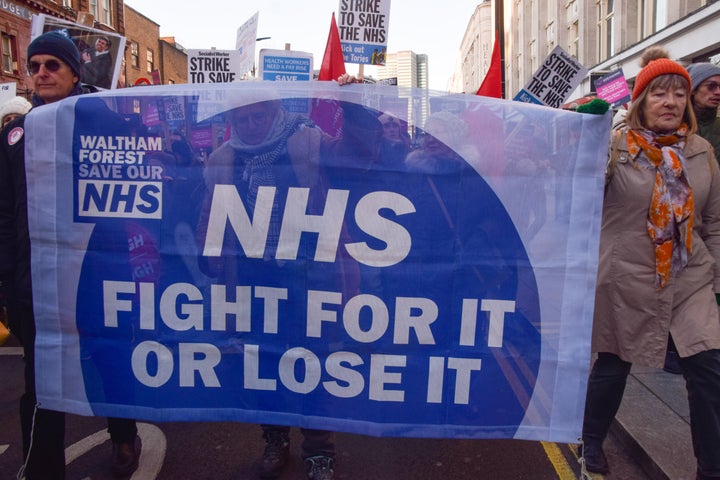
As NHS workers continue to strike over pay and working conditions, more people about how the health service operates – and just what increasing wages might mean for our taxes.
The government has resisted most public sector workers’ requests for pay increases over the last six months. PM Rishi Sunak claims he has an £1 billion “ambitious and credible plan” to fix the problems with the emergency and urgent care in England.
But it’s important to understand where the NHS funding actually comes from, how much of it goes towards its extensive workforce and what it would mean if the government increased pay.
HuffPost UK will take you through the basic mechanics of the health service’s finances.
How much does the NHS cost?
Spending for the NHS did increase over the last few years due to the additional costs of the Covid vaccine and the free Covid tests.
So, while the UK spent 10.2% of GDP on health in 2019 (an average among comparable countries at the time, according to think tank The King’s Fund) although this is estimated to have risen to 12.8% in 2020.
In 2019-2020, the NHS cost the department of health and social care £156 billion, in 2020-2021 it cost 201.4 billion, and in 2021-2022, £199 billion.
Projections show that spending in 2022-2023 will decrease.
The NHS should end up costing around £180.2 billion, with the subsequent annual budgets increasing by £2 billion each time.
What are the NHS’s main outgoings?
Health services are devolved in the UK, meaning the respective governments in Scotland, Wales and Northern Ireland manage their own annual budgets.
NHS England, which has the highest number of patients, and the NHS improvement for spending on health services, will receive £152.6 billion in 2022-2023.
Most of this (just under £108 billion) is allocated to local health services.
According to Sanctuary Personnel (a health and social care recruitment company), just under £30 billion is spent on directly commissioning services, including primary care services, specialised services and public health.
“The remaining money goes on service development and improvement programmes,” it adds.
The NHS in England employs around 1.2 million full-time equivalent staff as of June 2021.
So, unsurprisingly, approximately 46.6% of its total budget goes towards paying these staff members – this works out to £56.1 billion.
That does not include salaries for GPs (they’re funded indirectly through the NHS) employees for the government department of health and social care or NHS England.
It’s worth looking at how much procedures cost, too.
The average nine-minute GP consultation costs £39.23.
A simple trip to A&E can cost between £77 and £359, while average cost of a patient being taken to A&E in an ambulance was £292 (between 2019 and 2020).
The cost of an operation can range hugely, usually ending up in the thousands, and depends on how long the patient stays in hospital and where they are in the country.
So, how is this all NHS funded?
General taxation still accounts for most of the NHS fundings, in particular income taxes.
A small proportion comes from revenue – costs for prescriptions, dental treatment, car parking charges, land sales and offering private healthcare services.
In 2019/2020 the income from patient fees and charges for prescription and dental care was £1.5 billion or 1.1% of the total DHSC budget.
But, National Insurance Contributions (NICs) were also increased in April 2003 to boost funding.
According to the gov.uk website, between 2020 and 2021 21.9% of public expenditure was spent on health.
Each year, the level of NHS funding is set by central government through the Spending Review process.
This looks at how much income the NHS will receive from user chargers, NICs and general taxation.
It tries to balance it, so if NICs fall one year, then general taxation will be increased.
Why do people worry about it now?
NHS funding has decreased under the Tories, in real terms.
As the Institute of Fiscal Studies found, NHS spending between 1955-56 and 2019-2020 increased by an average of 4%.
But the annual rise has been below that for all but one year since 2010, with the average being made up of the large amount pumped into the health service prior to 2010.
So, that means staff wages are not stretching as far as they once did.
According to independent pressure group, the NHS Support Federation, these problems are exacerbated by the government’s repeated calls for big efficiency savings, which providers have found “unachievable”.
On top of that, private sector companies are winning big contracts, public funds are being diverted away, cuts to frontline staff, and nearly half of staff say underfunding stops them doing their job properly, according the NHS Support Federation.
Even Sunak’s new £1 billion, two-year plan to provide 800 new ambulances and 5,000 more sustainable hospital beds, with more people being treated at home, has been scrutinised.
Patricia Marquis, the royal college of Nursing’s director for England said that while these things were “desperately needed”, the real problem is “lack of staff”.
She said: “Extra beds are only safe when there are enough nurses for the patients in them. And because of the workforce crisis, existing services are unsafe.”
